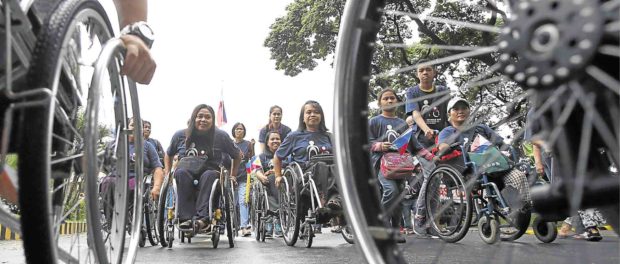Build more PWD-friendly facilities, spaces architects told

HELPING PWDS A group of architects has been pushing for a stricter implementation of the accessibility law to make all buildings in the country accessible to persons with disabilities (PWDs). –Niño Jesus Orbeta
ANGELES CITY—Architect Frank Sarmiento was asked on Saturday to spend an hour roaming around the classrooms of Holy Angel University here on a wheelchair.
He was one of four people who was asked to experience mobility around the campus on a wheelchair. Three others went around the same classrooms with blindfolds for an hour to simulate the experience of sightless people.
Architect Kenneth Descazo was strapped with two bags to simulate the extra weight carried by a pregnant woman while two others wore slings as they roamed the campus.
Sarmiento and nine people, who tried to experience the difficulties faced by the physically impaired, were among 106 building operators, local government employees, college deans and experts from Clark Development Corp. who attended a seminar that urged architects to make all buildings accessible to persons with disabilities (PWDs).
Low compliance
“We only have two buildings which follow the accessibility law in this country. The rest of the buildings put up by the government and the private sector are either 20 percent, 40 percent, 30 percent or 60 percent compliant to Batas Pambansa No. 344 (the accessibility law implemented in 1983) and Republic Act No. 7277 (Magna Carta for Disabled Persons),” said Erico Abordo, Quezon City chapter president of the United Architects of the Philippines (UAP).
UAP has been pushing for the strict enforcement of these laws through Abordo’s other group, Architects for Accessibility, which led the seminar.
Abordo said 1.6 million of 106.51 million Filipinos (1.57 percent) have some forms of physical disability and who occasionally struggle to gain access to public or private facilities.
Many buildings are required to have proper signs leading to ramps equipped with handrails, signs or devices that use Braille for the blind, or light signals for the hearing impaired.
“We are lagging behind Singapore which set about making its buildings PWD-friendly in 2007. Our laws were around when [the late President Ferdinand] Marcos governed the country but we had not made any headway after 30 years,” said architect Felizardo Cipriano, who represented the country in the 2017 Accessibility and Universal Design Convention in Malaysia.
“But the problem is no matter how many architects design PWD facilities for building projects, the final plans are still under the discretion of the building operators,” he said. —MARIA ADELAIDA CALAYAG